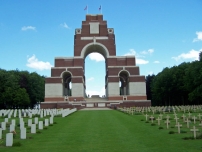| First Name: | Frederick | Last Name: | BARRETT | |
|---|---|---|---|---|
| Date of Death: | 27/07/1916 | Lived/Born In: | Regent's Park | |
| Rank: | Rifleman | Unit: | King's Royal Rifle Corps1 | |
| Memorial Site: | Thiepval Memorial, France | |||
Current Information:Born-St Giles The Battle of the Somme (July-November, 1916) On 1st July 1916 The British Army launched a massive offensive along a section of the front line running north of the River Somme. The French attacked south of it. The first day was a disaster for the British army which suffered nearly 60,000 casualties, 19,000 of whom were killed, and made hardly any inroads into the enemy lines. But the battle had to go on, if for no other reason than to relieve pressure on the French at Verdun where they had been facing the full onslaught of the powerful German Army. So it continued all the way through to November with nearly every battalion and division then in France being drawn into it at some stage. In the end the German trenches had been pushed back a few miles along most of the line but the cost in lives had been staggering. By the end of the fighting in November, 1916, British Army casualties numbered over 400,000, killed, wounded and missing. On 14th July, 1916, a second major offensive was launched, this time against the German second line of defences stretching from Longueval to Bazentin-le-Petit, but unfortunately, after a promising start which saw some important gains on the first day, the British Army once again reverted to a series of uncoordinated attacks, using out dated tactics. Not surprisingly they soon found themselves engaged in a war of attrition as they attempted to push the enemy further back across the Somme battlefield. This was no more so the case than in the fight to capture the village of Longueval and Delville Wood that lay next to it; a struggle that went on for many weeks through the summer of 1916. On 20th July, 1916, 2nd Division left the sector to the north of Arras and proceeded to the Somme battlefield to join in the carnage there. On 25th July they relieved 3rd Division in the southern half of Delville Wood where a great deal of fighting had already taken place turning the wood into a hopeless tangle of undergrowth, fallen trees, remains of trenches and dead bodies. It was not the best of introductions to the Somme. Two days later on 27th July, 1916, Delville Wood was attacked once again, this time by 99 Brigade moving up through the southern part of the wood and 15 Brigade of 5th Division attacking on their left. At 6.10am the British artillery unleashed an intense barrage on Delville Wood. An hour later 1st King’s Royal Rifle Corps and 23rd Royal Fusiliers, both of 99 Brigade made their move. The barrage of 125,000 shells had wreaked death and destruction among the German defenders and they made good progress, crossing over Princes Street and by 9am establishing a line just short of the northern edge of the wood. At this stage 1st Royal Berkshire, also of 99 Brigade, moved up to protect the flanks of the new positions. At 9.30am 1st King’s Royal Rifle Corps and 1st Royal Berkshire repelled a German counter attack on the eastern side of Delville Wood, assisted by 99th Company, Machine Gun Corps. These machine guns proved very effective but as the fighting continued six of them were put out of action. The struggle continued all day and the casualty list kept on rising as the German artillery bombarded their old trenches which were now in British hands. Further enemy counter attacks meant that some ground was lost in the north-east of the wood but the majority of Delville Wood was now firmly in British hands. The losses however had been very heavy for 99 Brigade and included Frederick Barrett of 1st King’s Royal Rifle Corps. |
||||
| « Back to Search Results | ||||
| If you think any of the information shown here is incorrect, Click Here to submit your amends and comments | ||||




